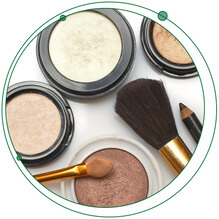 In today’s technical blog, I’m talking about the cosmetics industry so let’s get right to it. According to a Research and Market report, “The Global Cosmetic market was $460 billion USD in 2014 and is estimated to reach 675 billion USD by 2020, growing at a rate of 6.4%.”1 The U.S. leads the pack with a reported $62 billion in revenue earned in 20162. So, what am I getting at? We know earnings are strong and consumers like their products. But the question remains, are these products that you put on your skin, hair, and ingest safe? Such is the thinking of scientists like me and other chemists who are routinely tasked with detecting minimal levels of potentially harmful ingredients in personal care products against ever-changing global regulations.Read the Tech Note >
In today’s technical blog, I’m talking about the cosmetics industry so let’s get right to it. According to a Research and Market report, “The Global Cosmetic market was $460 billion USD in 2014 and is estimated to reach 675 billion USD by 2020, growing at a rate of 6.4%.”1 The U.S. leads the pack with a reported $62 billion in revenue earned in 20162. So, what am I getting at? We know earnings are strong and consumers like their products. But the question remains, are these products that you put on your skin, hair, and ingest safe? Such is the thinking of scientists like me and other chemists who are routinely tasked with detecting minimal levels of potentially harmful ingredients in personal care products against ever-changing global regulations.Read the Tech Note >
Take the United States for example where, apart from color additives, cosmetic products do not require Food and Drug Administration (FDA) approval3. While in other regions such as the European Union and China, governments have put in place stricter regulations, prohibiting the use of hormones, antibiotics, and disinfectants in cosmetics. To enable labs to have options for meeting regulations such as these, I wanted to mention the following technical note, Use of X500R QTOF for Monitoring of Additives in Cosmetics, in which our researchers established a highly selective, high throughput method for rapid screening and quantification of prohibited drugs in cosmetics. Some of the benefits of this method include:
- Rapid time savings
- Scope of compounds tested
- Single injection samples
- Simultaneous identification and quantification
More Information on Cosmetic Regulations and Lab Testing
Labs know that industry regulations are ever changing. For example, in 2015, two U.S. senators proposed legislation to give the FDA more power to regulate cosmetics.4 More recently, the FDA proposed a limit to adding lead in lipstick to 10 parts per million (ppm), an effort supported by the Personal Care Products Council. It’s not just the U.S. which is making efforts to monitor the cosmetics industry more closely. The Albanian Parliament too recently passed a law by the European Council Regulation no. 1223/2009.5 Additionally, the EU Cosmetics Committee recently voted for banning three more fragrance allergens.6
The point of which is that for labs such as CROs to stay in business, they must be ready for anything that comes their way. The cosmetic market may be growing, but so too is global awareness about harmful ingredients both amongst the public and manufacturers/governments are not sitting idle. The X500R QTOF System, as featured in the above technote, is a highly accurate, and affordable instrument that is sensitive enough to meet low levels of detection in the cosmetics products and fits into any lab as a benchtop product.
- http://www.businesswire.com/news/home/20150727005524/en/Research-Markets-Global-Cosmetics-Market-2015-2020-Market
- https://www.statista.com/statistics/243742/revenue-of-the-cosmetic-industry-in-the-us/
- https://www.fda.gov/aboutfda/transparency/basics/ucm262353.htm
- https://www.statnews.com/2016/09/27/cosmetics-fda-congress-safety/
- http://www.lexology.com/library/detail.aspx?g=920d68bd-6d8f-492d-b6ca-e0c6d4b1efc5
- https://chemicalwatch.com/54823/eu-cosmetics-committee-backs-fragrance-allergens-ban






 Contact Support
Contact Support
0 Comments